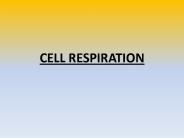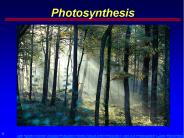Photosystem PowerPoint PPT Presentations
All Time
Recommended
Title: No Slide Title Author: Chanoch Carmeli Last modified by: Chanoch Carmeli Created Date: 5/19/2002 6:24:56 PM Document presentation format: On-screen Show
| PowerPoint PPT presentation | free to view
Coral bleaching and thermal stress: The first step is not damage to Photosystem II. ... Elevated temperature and coral-dinoflagellate symbioses. ...
| PowerPoint PPT presentation | free to view
... of Photosystem II from Thermosynechococcus elongatus at 3.5 angstrom resolution. Kristina N. Ferreira, Tina M. Iverson, Karim Maghlaoui, James Barber, and So Iwata ...
| PowerPoint PPT presentation | free to view
The photosynthetic conversion of solar energy to chemical energy is the main ... direct observation by time-resolved high-field electron paramagnetic resonance ...
| PowerPoint PPT presentation | free to view
Photosynthesis Plant Cell The Chloroplast Chlorophyll Pigments and e- Excitation Photosystems Photosystems Photosynthesis Animations Light Reactions Photosystems ...
| PowerPoint PPT presentation | free to view
Light reactions or photochemical phase is directly depends on light Light reaction phase include Light absorption Splitting of water molecule Release of oxygen molecule Formation of high energy chemical intermediates (ATP and NADPH) Several protein complexes are involved in the process The pigments are organised into two discrete photochemical light harvesting complexes (LHC) within the Photosystem I (PS I) and Photosystem II (PS II).
| PowerPoint PPT presentation | free to download
Light dependent Reactions Light dependent reactions Light independent reactions Light independent reactions Photosystem II (P680 ... Photosystem I (P700 ...
| PowerPoint PPT presentation | free to view
... Structure of Chloroplast. Pigment absorption spectra. Chlorophyll Structure. A photosynthetic unit. Photosystem II. Electron transport from II to I. Photosystem I ...
| PowerPoint PPT presentation | free to view
photolysis. H2O. NADP NADPH. e. ATP. ATP SYNTHASE. PHOTOSYSTEM I. PHOTOSYSTEM ... Photolysis in the thylakoid compartment splits water. Figure 7.15. Page 124 ...
| PowerPoint PPT presentation | free to view
UNIT FOUR Chapters 6, 7, and 8 PHOTOSYSTEM STRUCTURE Saturation Antenna Complex REACTION CENTER Transmembrane protein-pigment complex Passes an electron to a neighbor ...
| PowerPoint PPT presentation | free to view
Enzyme NADP reductase transfers electrons to NADP making NADPH. Cyclic Electron Flow ... reductase. NADPH. ATP. Photosystem II. Photosystem I. NADP ...
| PowerPoint PPT presentation | free to view
8.3 The Process of Photosynthesis The Light-Dependent Reactions: Generating ATP and NADPH Thylakoids contain clusters of chlorophyll and proteins known as photosystems.
| PowerPoint PPT presentation | free to download
Inside a chloroplast. Light Dependant Reactions ... It occurs in the thylakoid of a chloroplast. Pigments in photosystem II absorbs light. ...
| PowerPoint PPT presentation | free to view
Organization of an anoxygenic photosystem in the bacterial membrane ... Methanogens may be autotrophic or organotrophic. obligate anaerobic archaea. Fermentation ...
| PowerPoint PPT presentation | free to view
2. ATP to light independent reaction (stroma) From photosystem II ... Occurs in stroma of chloroplast. Uses C from CO2 and H from NADPH to form C6H12O6 ...
| PowerPoint PPT presentation | free to download
What colors of light are best absorbed by the chlorophyll molecules? ... 1. Photons reach the chlorophyll molecules in the photosystems found on the ...
| PowerPoint PPT presentation | free to view
Absorption Spectra of Major Photosynthetic Pigments ... of Photosystem II from Thermosynechococcus elongatus at 3.5 angstrom resolution ...
| PowerPoint PPT presentation | free to view
LIGHT DEPENDENT REACTIONS OF PHOTOSYNTHESIS (1) As light falls upon the pigments of the chloroplast, energy causes the electrons in photosystem II (p680) to leave the ...
| PowerPoint PPT presentation | free to view
Photolysis (Light dependent) Electron Transport chain (Light dependent) ... near the pigments of Photosystem II in the interior of the thylakoid (photolysis) ...
| PowerPoint PPT presentation | free to view
Absorption of light. Transformation to chemical energy - redox ... Absorb light - Antenna. Electron transfer - Reaction Center. A Photosystem. Antenna. Reaction ...
| PowerPoint PPT presentation | free to view
Chlorophyll Fluorescence - Measurement of Photosystem II Activity ... Correlation with extracted chlorophyll and/or leaf nitrogen are high. ...
| PowerPoint PPT presentation | free to view
CELL RESPIRATION The Light dependent reactions: Light strikes the Photosystem II causing it to transfer e to primary electron acceptor at the reaction centre.
| PowerPoint PPT presentation | free to download
Chapter 19 Photosynthesis 2. Lecture 15. The Thylakoid Membrane. PSII. Photosystem II ... Dark Reactions of Photosynthesis. Used 14C. And paper chromatography ...
| PowerPoint PPT presentation | free to view
chlorophyll is organized along with proteins and smaller organic molecules into photosystems. ... reaction-center chlorophyll and primary electron ...
| PowerPoint PPT presentation | free to view
Chloroplast site of photosynthesis and starch formation ... Stacked like pancakes. These stacks are called grana. Structure of the Plant Photosystem ...
| PowerPoint PPT presentation | free to view
granum) which contain chlorophyll and other important molecules. ... Chlorophyll. Photosystems. energy. transfer. energy transfer. energy transfer. energy transfer ...
| PowerPoint PPT presentation | free to view
Why are plants green? Pigment Spectra. Action Spectra. Chlorophyll. Electron Excitation. Passing the Buck. Photosystem II. Non-cyclic Photophosphorylation ...
| PowerPoint PPT presentation | free to download
Boosted electrons replaced by the PHOTOLYSIS of water. Splitting of water ... Photosystem II: electrons from photolysis of water replace chlorophyll electrons ...
| PowerPoint PPT presentation | free to view
Use highly conserved chloroplast gene from Photosystem II part of the light ... Sequence for the promoter of 35S transcript of the Cauliflower mosaic virus. ...
| PowerPoint PPT presentation | free to view
To encourage chemist, physicist and basic science researcher ... Water Photolysis in Biology. Photosystem II (PSII) is the heart of the photosynthetic process. ...
| PowerPoint PPT presentation | free to view
Oxygen released during photosynthesis changed the atmosphere ... Photosystem II replaces lost electrons by pulling them from water (photolysis) ...
| PowerPoint PPT presentation | free to view
split water (oxidize water to O2) produce NADPH, ATP (via PMF) uses 2 photosystems ... P680 is oxidized as looses e- to pheophytin ...
| PowerPoint PPT presentation | free to view
Carotenoid-less non-photochemical quenching by Photosystem I PSI complex exists in cyanobacteria as a trimer, in plants as a monomer.
| PowerPoint PPT presentation | free to download
Chloroplast: organelle in which the process of photosynthesis takes place ... photosynthetic membranes of the chloroplast (grana) contain PHOTOSYSTEMS which ...
| PowerPoint PPT presentation | free to view
Photosystem II is not needed to supply electrons, and no O2 is evolved from water. Can the chloroplast produce NADPH in this way? A: No NADPH is formed, ...
| PowerPoint PPT presentation | free to view
DBMIB work in a step later than DCPIP and it does. not block the ... step latter than photosystem I. Today. we will perfrom the photosynthesis on a molecular ...
| PowerPoint PPT presentation | free to download
Identifying the roles of protein subunits in solar water-splitting Robert Fagerlund, PhD Department of Biochemistry University of Otago Photosynthesis Solar powered ...
| PowerPoint PPT presentation | free to view
Energy, part II - pc|mac ... Photosynthesis
| PowerPoint PPT presentation | free to download
Title: Photosynthesis Author: Michael and Mary Last modified by: Michael Gregory Created Date: 10/16/1994 10:42:18 PM Document presentation format
| PowerPoint PPT presentation | free to view
Photosynthesis Capturing the Energy in Light 6CO2 + 6H2O - C6H12O6 + 6O2
| PowerPoint PPT presentation | free to view
Photosynthesis Chapter 9 * * * * * * * * * * * * * * * * * * * * * * * * * * * Light dependent reactions: Summary Non-cyclic electron flow Generates ATP and NADPH ...
| PowerPoint PPT presentation | free to view
I took an earthenware vessel, placed in it 200 pounds of soil dried in an oven, ... (when necessary) only with rainwater or distilled water, and it was large enough ...
| PowerPoint PPT presentation | free to view
Photosynthesis By Dr. Huq
| PowerPoint PPT presentation | free to download
1) Light rxns use light to pump H+ use pH to make ATP by chemiosmosis 2) Light-independent (dark) rxns use ATP & NADPH from light rxns to make organics
| PowerPoint PPT presentation | free to download
Title: PowerPoint Presentation Author: McDougal Littell Last modified by: Greenwood School District 50 Created Date: 9/14/2006 4:17:10 PM Document presentation format
| PowerPoint PPT presentation | free to download
LIGHT REACTION OF PHOTOSYNTHESIS. 1. Photosynthetic reaction. 1) 6 ... P960 (special pair) bacteriochlorophyll (BChl) bacteriopheophytin b (BP) QA (quinone) QB ...
| PowerPoint PPT presentation | free to view
Title: No Slide Title Author: OCSD Last modified by: OCSD Created Date: 10/12/2001 4:08:51 PM Document presentation format: On-screen Show Company
| PowerPoint PPT presentation | free to view
Chapter 10 Photosynthesis
| PowerPoint PPT presentation | free to download
Photosynthesis Chapter 8 * Photosynthesis Overview Energy for all life on Earth ultimately comes from photosynthesis. 6CO2 + 12H2O C6H12O6 + 6H2O + 6O2 ...
| PowerPoint PPT presentation | free to view
Photosynthesis The Flow of Energy Autotrophs vs. Heterotrophs Autotrophs self-feeders , an organism that makes all its own organic matter from inorganic ...
| PowerPoint PPT presentation | free to view
Photosynthesis Chapter 10 * Figure 10.21 A review of photosynthesis Figure 10.22a A review of photosynthesis (part 1) * Figure 10.23 Make connections: the working ...
| PowerPoint PPT presentation | free to download
Photosynthesis Learning objective To be able to explain that light energy is absorbed by electrons in chlorophyll Some excited electrons gain enough energy to leave ...
| PowerPoint PPT presentation | free to download
Light from the sun appears white but it is actually composed ... 2) Calvin Cycle or Dark Reaction. Photosynthesis Reaction. Chloroplast Structure. 2 membranes ...
| PowerPoint PPT presentation | free to view
Photosynthesis Chapter 10
| PowerPoint PPT presentation | free to view
Two parts of Photosynthesis ... Chloroplast. Surrounded by two membranes. Thylakoids flattened sacs that contain chlorophyll ... Chloroplast Pigments ...
| PowerPoint PPT presentation | free to view
Any green part of a plant contains chloroplasts ... Chloroplast Structure. How Light is Absorbed. How it Works. The Light Reactions (Step 1) ...
| PowerPoint PPT presentation | free to view
























































